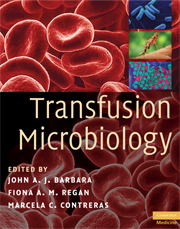Book contents
- Frontmatter
- Contents
- List of contributors
- Foreword
- Preface
- Acknowledgements
- Glossary
- Introduction: Transfusion-transmitted infections, then and now
- Section 1 Agents
- Section 2 Selection and testing
- 10 Blood donor selection and qualification
- 11 Current serological methods of testing and automation
- 12 Confirmatory testing and donor re-admission
- 13 The strategy for applications of nucleic acid testing
- 14 Nucleic acid testing: general view
- 15 Nucleic acid testing: the US approach
- 16 Nucleic acid testing: the UK approach
- 17 Quality in the screening of donations for transfusion-transmissible infections
- 18 Microbiological blood testing and new technologies
- 19 Processing and components: leucodepletion and pathogen reduction
- 20 Fractionated products
- Section 3 Surveillance, risk and regulation
- Index
- Plate section
- References
19 - Processing and components: leucodepletion and pathogen reduction
from Section 2 - Selection and testing
Published online by Cambridge University Press: 12 January 2010
- Frontmatter
- Contents
- List of contributors
- Foreword
- Preface
- Acknowledgements
- Glossary
- Introduction: Transfusion-transmitted infections, then and now
- Section 1 Agents
- Section 2 Selection and testing
- 10 Blood donor selection and qualification
- 11 Current serological methods of testing and automation
- 12 Confirmatory testing and donor re-admission
- 13 The strategy for applications of nucleic acid testing
- 14 Nucleic acid testing: general view
- 15 Nucleic acid testing: the US approach
- 16 Nucleic acid testing: the UK approach
- 17 Quality in the screening of donations for transfusion-transmissible infections
- 18 Microbiological blood testing and new technologies
- 19 Processing and components: leucodepletion and pathogen reduction
- 20 Fractionated products
- Section 3 Surveillance, risk and regulation
- Index
- Plate section
- References
Summary
Although donor selection and donation screening remain the critical elements of protection from transfusion-transmitted pathogens, there is increasing interest in achieving further safety enhancements by component modification. In the last five years, leucocyte depletion has moved from being a bedside procedure for specific patients to a universal and integral part of component processing. In this context, its potential for removal of leucocyte-associated viruses has been the subject of considerable debate. Over the same time period, techniques for pathogen reduction of fresh frozen plasma and platelets have been developed and, in some cases, licensed for routine use. Pathogen reduction for red cells is proving a more challenging prospect, but in time the current difficulties may be overcome. Such techniques present policy-makers with interesting decisions which must take into account cost-effectiveness, loss of functionality of components, potential toxicity, and the potential impact on current donor selection and screening policies.
Leucocyte depletion (LD)
Many countries now undertake universal LD of all components in blood centres within 1–2 days of collection. The reasons for this practice vary from country to country, but perceived benefits include reduced immunomodulation, fewer febrile reactions, and reduction of cytomegalovirus risk (reviewed in Williamson, 2000). In the UK, the main reason for implementation of universal LD was as a precaution against transmission of variant Creutzfeld-Jacob disease. Leucocyte depletion is achieved either by filtration of either whole blood or processed components, or by centrifugation/elutriation during platelet apheresis.
- Type
- Chapter
- Information
- Transfusion Microbiology , pp. 239 - 258Publisher: Cambridge University PressPrint publication year: 2008
References
- 1
- Cited by



